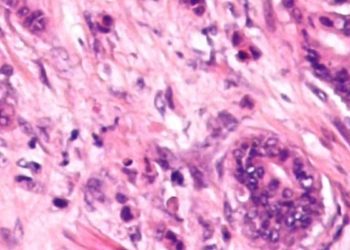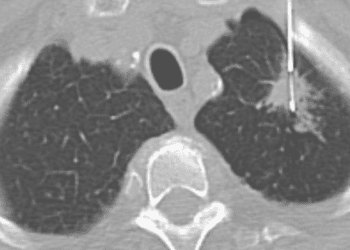Lung cancer screening with low-dose CT most effective for those at high risk
Image: PD
1. Individuals at high risk of lung cancer stand to benefit from screening with low-dose CT, whereas those at low risk of lung cancer do not.
Evidence Rating Level: 1 (Excellent)
Study Rundown: The National Lung Screening Trial (NLST) identified individuals at high risk of lung cancer by the following criteria: 55 to 74 years old, smoking history of 30 pack-years or more and 15 years or less since quitting. In this group, screening with low-dose computed tomography (CT) was found to prevent a significant number of lung cancer deaths compared to conventional radiography.
Most agree that screening should be reserved for those at high risk since they stand to benefit most. For any screening test, sensitivity and specificity are key parameters. Does the test detect tumors reliably without generating excessive false positives? Additionally, the prevalence of disease in the screened population must be considered. A positive test in a population with high disease prevalence is more meaningful than a positive test in a low-prevalence population because the former is less likely to be a false alarm.
In this study, the authors revisit the NLST data and stratify patients into quintiles of risk in order to demonstrate empirically that low-dose CT screening is best applied to patients at high risk for lung cancer.
Click to read the study, published today in NEJM
Relevant Reading: The National Lung Screening Trial: Overview and Study Design
In-Depth [statistical study]: First, the authors developed a risk-prediction model to stratify the NLST participants into risk quintiles, with the highest-risk quintile having a 2.00% 5-year risk of lung cancer mortality and the lowest-risk quintile having an 0.15 to 0.55% risk. This model was validated against data from the PLCO trial (another cancer screening trial).
After stratifying the participants into these risk quintiles, the authors found, as expected, that there were more lung cancer deaths prevented and fewer false positives in the highest-risk quintile. For comparison, in the lowest-risk group, 5276 individuals had to be screened to prevent a single lung cancer death, whereas in the highest-risk group, only 161 had to be screened.
In light of these findings, the key question for the application of this screening test is how best to identify “high-risk” individuals. The NLST study criteria provide a starting point, but efforts have been made to develop better risk-prediction models in order to optimize the application of the screening test. The goal, as ever, is to maximize deaths prevented while minimizing false positives. A consensus on the best means of risk prediction is yet to emerge.
By Tomi Jun and Mitalee Patil
More from this author: Early risk factor for progression of cystic fibrosis identified, Gut microbes implicated in stroke and heart attacks: new dietary link, New leukemia mutation offers therapeutic targets, Childhood ADHD associated with increased risk of suicide, A marker of aggressive liver cancer and potential therapeutic target identified
© 2013 2minutemedicine.com. All rights reserved. No works may be reproduced without expressed written consent from 2minutemedicine.com. Disclaimer: We present factual information directly from peer reviewed medical journals. No post should be construed as medical advice and is not intended as such by the authors, editors, staff or by 2minutemedicine.com. PLEASE SEE A HEALTHCARE PROVIDER IN YOUR AREA IF YOU SEEK MEDICAL ADVICE OF ANY SORT.


![2 Minute Medicine: Pharma Roundup: Price Hikes, Breakthrough Approvals, Legal Showdowns, Biotech Expansion, and Europe’s Pricing Debate [May 12nd, 2025]](https://www.2minutemedicine.com/wp-content/uploads/2025/05/ChatGPT-Image-May-12-2025-at-10_22_23-AM-350x250.png)




